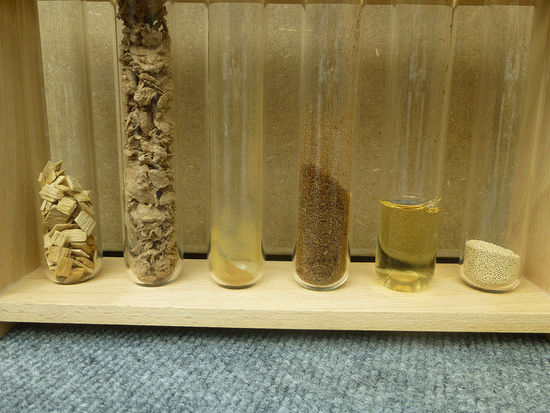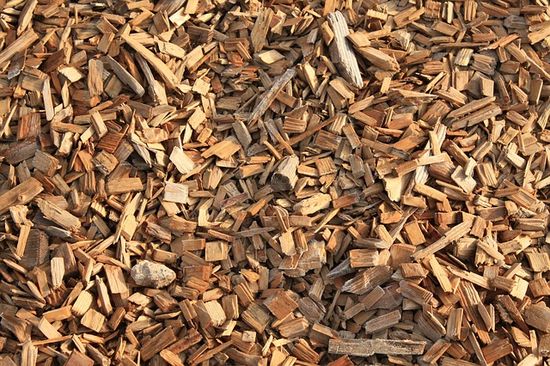Lignin

Background
Lignin is a complex and heterogeneous polymer found in wood. It composed of aromatics crosslinked with carbohydrates. If is the second largest component of biomass on Earth and has many applications. Lignin is difficult to decompose in the wild and a dense source of energy when combusted. Lignin may be an a source of aromatic compounds for OSE.
OSE context
Aromatics from lignin
Phenols and benzenes can be produced from lignin using catalytic hydrocracking, high heat with a hydrogen feed. A variety of valuable chemicals are produced by the decomposition of lignin but a major challenge lies in purification. Pyrolysis/hydrocracking are a current OSE goal and have been demonstrated to yield aromatics from lignin. Depending on the approach produced aromatics may be in a complex mixture or greater decomposition can be pursued to produce a more uniform mixture of simpler products. Aromatics are necessary for a variety of chemical engineering applications and eventual product ecologies and a method of their production from local resources is necessary.
For OSE purposes approach 2 may be most suitable due to its ability to yield model molecules that can be converted to necessary aromatics (isolate phenols and use a straightforward conversion to desired molecules). Expired patented technology seems within OSE reach with high pressure and high temperature Fluidized bed reactor.
A select few aromatics may all that is necessary to produce the majority of OSE product ecologies and it may not be necessary to pursue a very large number of complex aromatics. A rational approach that looks at the OSE product ecologies, their chemical substrates and OSE capabilities to produce those substrates may find overlap or substitutions and pyrolysis and molecule rebuilding can be directed along a few channels.
Aromatics necessary for OSE product ecologies
- Phenol
- P-toluene sulfonic acid for Polylactic acid production - pure para configuration may not be necessary, though its production should be favored due to steric hindrances, ortho and meta substitution configurations may have different acid behavior, this product ecology needs further exploration
Literature and patent review
The Catalytic Valorization of Lignin for the Production of Renewable Chemicals by Zakzeski et al (2009) provides a very good review of the current state of capturing chemical materials from lignin and maps the available literature on the field, provides figures and schemes of lignin related products and paths for their conversion. Reviews background of lignin structure and techniques of using lignin as source of platform chemical structures for value adding, value adding during breakdown, reduction and oxidation schemes, and catalyst technology for all of these processes. Lignin acts as a glue holding together the cellulose and hemicellulose in the cell wall and is composed of three phenylpropane subunits namely, coniferyl, sinapyl, and p-coumaryl. There are three strategies to utilizing lignin for chemical materials: 1. pyrolysis to simple component molecules that can be purified and used to build desired complex molecules (based on petrochemical processes) 2. removal of functional groups and isolation of aromatics which can be used to build desired complex molecules (based on petrochemical processes) 3. Use of highly selective catalysts for the direct production of desired chemicals by interrupting targeted functional groups (based on novel biorefinement processes). Purification technology is a essential to all three strategies and needs further development.
Pretreatment of biomass is essential to the start of biorefinement techniques and pretreatment of lignin is enhanced by proper pairing of pretreatment with the lignin structure. Pretreatments can be split into 4 broad categories physical, chemical, solvent, and biological. Pretreatment parameters must also be carefully selected including temperature, pressure, pH, etc. The authors reference polyoxometalate as an alternative to the chlorine based pulping process. The Kraft process is the main industrial treatment utilized in pulping mills and involve high temperatures between 423-453 K, high pHs and sodium hydroxide and sodium sulfide, however to be economical lignin is used for combustion for energy and not all recalcitrant (5-5) linkages are broken. Organosolv pretreatment utilizes an organic solvent extraction to produce streams of cellulose, hemicellulose, and lignin fractions and has been demonstrated industrially, however the process is hampered by the high cost of solvent and their recovery. Pyrolysis is another pretreatment but consumes carbon in the process and needs high temperature. A related treatment is steam explosion in which steam at 453-503 K is introduced under pressure 1.38-3.45 MPa for 1-20 min and then rapidly vented resulting in the separation of lignin fibers.
The most common linkage in lignin is B(eta)-O-4 which are readily cleaved by current processes and releases phenylpropane subunits. Certain configurations are not readily broken down. Carbon carbon bonds are the most difficult to break and are an area where catalysis research is necessary. The most recalcitrant configurations are crosslinked aromatics, particularly pentoses with a 5-5 linkage. The p-coumaryl subunit is the least substituted and removal of the para-alkene via reduction produces phenol. Coniferyl subunit's R substituent can be oxidized yielding vanillin a high value fragrance and taste additive. Sinapyl alcohol subunits also can serve as a model for numerous desirable molecules and is not susceptible to repolymerization due to the occupation of the 3 and 5 positions. The authors catalogue a huge variety of chemicals that can be derived from the model subunits and reported protocols for their preparations (see figures 12-14).
Dissolution technology has been investigated using organic, ionic, and supercritical water solvents. DMSO/NMI has been found to be an effective organic solvent for wood that can be used to separate the carbohydrate and lignin fractions. dUse of solvents significantly raises the costs of processing unless the solvent can be recovered efficiently. CO2 expanded organic solvents have been explored for their ability to finetune solubility recover high value lignin components. Ionic liquids have been examined and the solution effect is strongly controlled by the anion used. Effective anions for lignin and wood dissolution have been found to include to [EMIM],[CF3SO3]-
or [MeSO4]-. Alternatively cellulose can be extracted using a solvent, leaving a lignin rich residue.
US patent 4,647,704 issued to Engel et al on March 3, 1987 describes a method of hydrocracking lignin using a tungsten/nickel catalyst supported on a mildly acidic base, notably alumina, silica, alumina phosphate or a combination. The catalyst has superior due to the combination of a cracking catalyst tungsten and a hydrogenating catalyst nickel. The products are phenol or cresols, a methyl phenol, a benzene with a hydroxyl and methyl substitution. The process is conducted in a reactor under a hydrogen atmosphere at pressures of 500 - 3500 psig and temperatures of 300-450 C. Yield is improved with the use of a low weight aliphatic alcohol, namely methanol, in a percentage of up 25% but usually between 7-15%. Inclusion of methanol increases the yield of cresols. A water content of up to 25% wt lignin is found to have optimal yields and additional process improvements include the inclusion of a lewis acid/friedel-crafts (alkylates and acylates benzene) catalyst, namely AlCl3. Lignin from the kraft process or any nonbasic form is suspended in a nonreactive solvent but phenol was found to have the best performance.
The catalyst consists of 2-20% weight tungsten component preferably the zerovalent metal but tungsten sulfide may be used. Tungsten by itself may be used (has both cracking and hydrogenation activity) but a second hydrogenating catalyst enhances action. Preferably nickel (but also palladium) is an effective cocatalyst in the zerovalent metal state and should be combined with the tungsten in a molar ratio nickel:tungsten of 5:1-20:1. Friedel craft catalysts used include iron, antimony, zinc, tin, and aluminium as particularly bromides or chlorides but also fluorides and phosphates and are included in 0.5-5.0% wt lignin. A Fluidized bed reactor has superior performance compared to fixed bed reactors.
After further R&D the examples should be reviewed for optimal performance and adherence to OSE product ecologies.
Basic Studies on the Pyrolysis Products of Lignin by Hwang and Obst utilized model lignin compounds for pyrolysis and analyzed the products by GC-MS. Arylglycerol-ß-arylether (substituted aromatics linked through two carbons one as a C-C bond with hydroxyl group and one ether linkage) linked compounds served as model lignin structures and were pyrolysized at 250-500 C. Pyrolysis at 315 C was found to be optimal. Products were dimethoxyacetonophenone (DMAP), trimethoxyacetonphenone (TMAP), and dimethoxyphenol (DMP) and their exact yields were dependent on the starting material. The yield of aromatic products were higher in veratryl than trimethoxyphenol possibly due to pyrolysis being easier.
http://www.google.com/patents/US3105095
http://www.cellulosechemtechnol.ro/pdf/CCT9(2010)/P.353-363.pdf
http://www.google.com/patents/US4420644
http://www.youtube.com/watch?v=smdPlIrqIX0
http://www.farmfoundation.org/news/articlefiles/1731-RC%20Brown%20USDA%20Workshop%20Nov%2016.pdf
http://www.pnl.gov/main/publications/external/technical_reports/PNNL-18944.pdf
